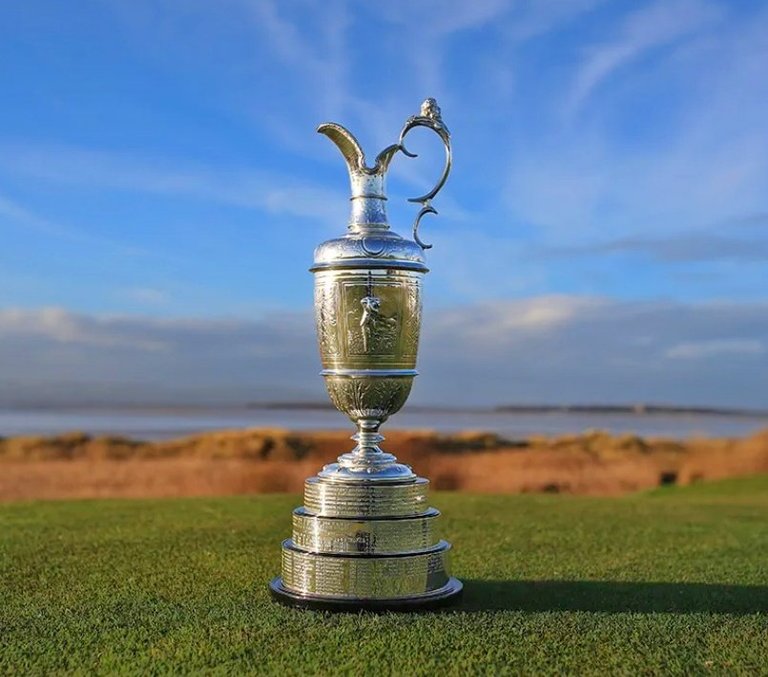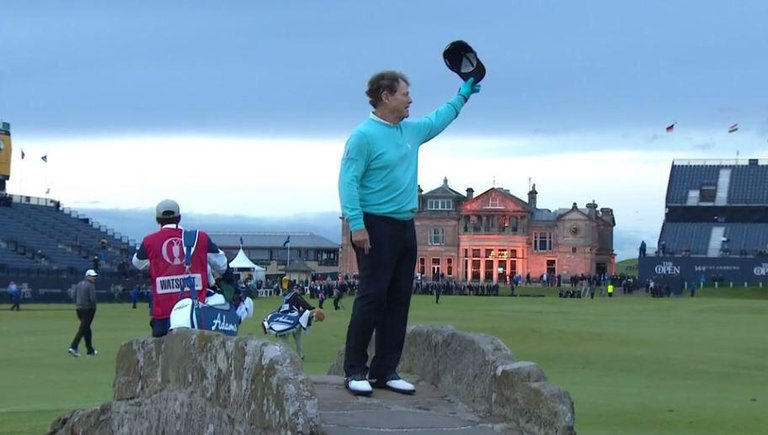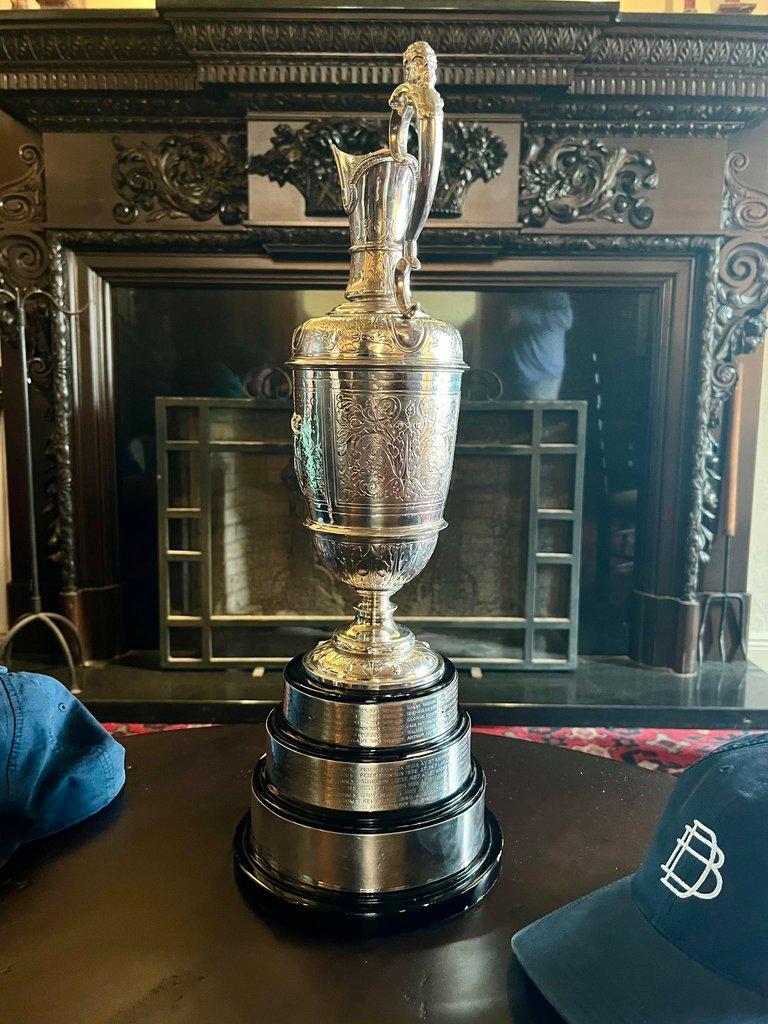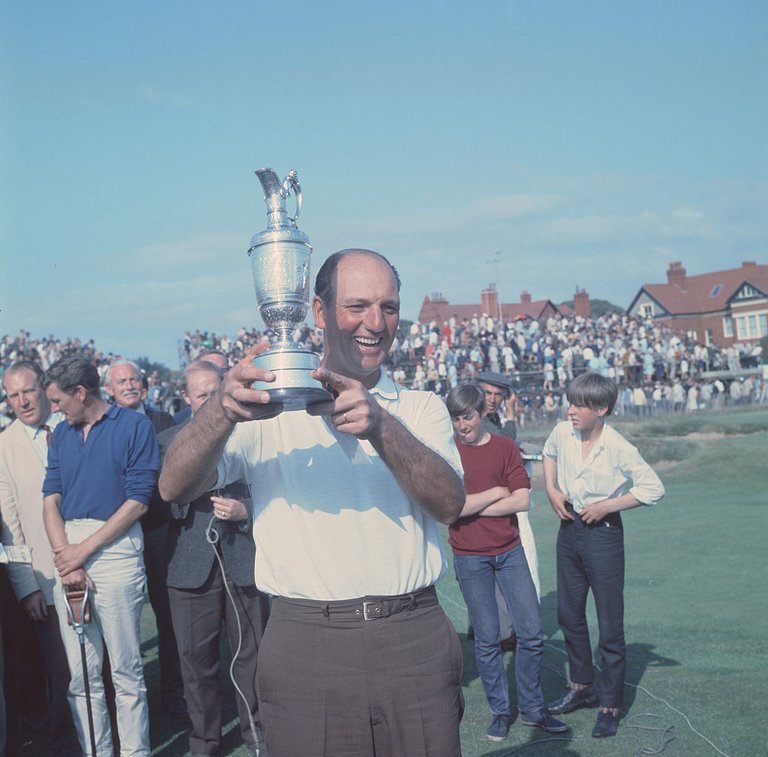Claret Jug (SPA-ENG)

A partir del día de ayer comenzó a disputarse el Open Championship, el cuarto y último major del año, el único que se desarrolla fuera de los Estados Unidos de América, el más antiguo y tradicional torneo de golf que comenzó a disputarse en el año 1860 y va por la edición 153.
Este artículo que hace mención del nombre del trofeo que se entrega al ganador al finalizar cada edición, pretende hablar más de la copa que de tan importante torneo, créanme que vale la pena.
Durante las primeras ediciones, el campeón recibía como trofeo simplemente un cinturón de cuero, recién para la edición de 1873 comenzó a entregarse la famosa jarra de plata. Desde entonces, la Claret Jug es el símbolo máximo que todo golfista quiere alzar y el Open Championship es el torneo más importante y de mayor tradición en este singular deporte.
La historia cuenta que la "jarra de clarete" fue encargada para reemplazar al cinturón de cuero que fue obtenido en forma absoluta y definitiva por Tom Morris Jr. en 1870 al imponerse en el torneo por 3 años consecutivos.
En aquel momento, los clubes St Andrews, Musselburgh, y Prestwick aceptaron hacerse cargo de la organización del Open y un tiempo después donaron 10 libras cada uno para confeccionar un nuevo trofeo, el retraso en la decisión provoco que en 1871 no hubiera torneo debido a la falta de un galardón adecuado para entregar al campeón.

Para la edición de 1872, al no estar finalizada la construcción de la jarra, se resolvió entregar al ganador una medalla de oro con la inscripción ‘Golf Champion Trophy’, la misma fue obtenida por Tom Morris Jr. que se impuso de esa manera por cuarta vez consecutiva. La llegada del nuevo trofeo aseguró la continuidad del campeonato, en la base del mismo se grabó la misma inscripción que en la medalla del año anterior.
El primer ganador de la Claret Jug fue un caddie analfabeto llamado Thomas Kidd, sin embargo, su nombre no fue el primero que se grabó en el trofeo sino el de Tom Morris Jr., en reconocimiento a su victoria del año anterior.
El Royal & Ancient (R&A) entidad original y rectora del golf británico, incluyó entre las reglas del torneo una cláusula de "uso perpetuo" que blindaba al trofeo de que algún jugador la obtuviera en forma definitiva como ocurrió con Morris y el cinturón. La primera víctima de la mencionada cláusula fue Jamie Anderson quien en 1879 ganó el abierto británico por tercera vez consecutiva, se le reclamó su restitución para el año siguiente.

El trofeo se mantuvo en uso durante muchos años, se entregaba al ganador de la edición vigente y volvía a la R&A al año siguiente para ser entregado al nuevo vencedor; para 1927 los norteamericanos Walter Hagen y Bobby Jones eran los dominadores del golf mundial repartiéndose las victorias en todos los torneos mayores incluido el Open Championship. Había llegado a los oídos de los directivos de la R&A que en noviembre de 1925, el trofeo original que se entregaba al ganador del US Amateur se había fundida gracias a un incendio en el East Lake Country Club de Atlanta, donde Bobby Jones lo había dejado para su custodia, consecutivamente, otra noticia puso nuevamente en alerta a los mismos dirigentes al enterarse que Walter Hagen "perdió" el enorme trofeo Wanamaker tras su victoria de 1926 en el PGA Championship celebrado en el Salisbury Golf Club de Nueva York. Estos eventos desafortunados provocaron la poco simpática y secreta decisión de encargar una réplica, la misma era una copia exacta de la original, excepto por el sello de 1927 que en aquel momento era exigido por la ley británica.
El trofeo original fue discretamente retirado luego de la devolución de Jones tras su victoria de 1927. Nunca más se utilizó. Hoy está debidamente guardado en una vitrina de seguridad en los pasillos de la sede del R&A y solo se utiliza una vez al año para grabar el nombre del ganador, pulirlo con un paño especial y volver a guardarlo hasta el próximo año. El encargado de grabarlo era el difunto Alex Harvey quien tardaba aproximadamente 20 minutos en estampar el nombre del ganador, el trofeo se exhibe una vez al año, el 30 de noviembre, fecha en que la sede del club R&A abre sus puertas al público.
Este tema de las réplicas no es algo que al Royal & Ancient Golf Club le guste comentar abiertamente, pero se sabe que al menos existen cinco trofeos del Abierto que se fabricaron a lo largo de los años. La primera y original Claret Jug fue fabricada en 1873, una réplica fue confeccionada para 1927 y luego se encargaron otras tres versiones relativamente modernas.

Cada una de ellas es copia exacta de la original, la primera de las tres versiones más recientes se encuentra en exhibición en el Museo Británico de Golf en St. Andrews, otra en el Salón Mundial de la Fama del Golf en Florida; La tercera y última se utiliza para exhibiciones y se lleva por todo el mundo para diversos eventos clasificatorios para este torneo.
El máximo ganador de la Claret Jug es el británico Harry Vardon quien la obtuvo en 6 oportunidades entre los años 1896 y 1914, en la época moderna y en segundo lugar el norteamericano Tom Watson la levantó en 5 ocasiones, la última en 1983, en 2009 con 59 años de edad a punto estuvo de obtener el sexto título que hubiera sido heroico, perdió en desempate ante Stewart Cink.
Sudamérica tiene un solo ganador de este trofeo, mi compatriota Roberto De Vicenzo la obtuvo en el año 1967.

La Claret Jug, confeccionada íntegramente en plata esterlina, mide 50 centímetros de alto y pesa aproximadamente 2 y medio kilogramo, la mayoría de los campeones la han levantado, besado, abrazado, acunado y utilizado para atrapar mariquitas, cosa que hizo Padraig Harrington incentivado por su pequeño hijo al obtener el trofeo por segunda vez consecutiva en el año 2008.
Tiger Woods la llenó y bebió champagne Don Perignon desde ella, John Daly Coca-Cola light, Ernie Els ron con grosellas negras y Stewart Cink se animó a llenarla con salsa barbacoa picante.
Sea cual haya sido el uso dado por aquellos que la obtuvieron decididamente es uno de los trofeos más reconocidos del deporte alrededor del mundo.
Claret Jug
Starting yesterday, the Open Championship, the fourth and final major of the year, the only one held outside the United States of America, began playing. The oldest and most traditional golf tournament, which began in 1860 and is now in its 153rd edition.
This article, which mentions the name of the trophy awarded to the winner at the end of each edition, aims to talk more about the trophy than about such an important tournament. Believe me, it's worth it.
During the first editions, the champion simply received a leather belt; it wasn't until the 1873 edition that the famous silver jug began to be awarded. Since then, the Claret Jug has been the ultimate symbol every golfer aspires to hold, and the Open Championship is the most important and traditional tournament in this unique sport.
History tells us that the "claret jug" was commissioned to replace the leather belt, which was won outright and definitively by Tom Morris Jr. in 1870 when he won the tournament for three consecutive years.
At that time, the St. Andrews, Musselburgh, and Prestwick clubs agreed to take over the organization of the Open and, a short time later, each donated 10 pounds to create a new trophy. The delay in this decision meant that the tournament was not held in 1871 due to the lack of a trophy to award to the champion.
For the 1872 edition, as the jug was not finished, it was decided to award the winner a gold medal inscribed with the "Golf Champion Trophy." Tom Morris Jr. won this medal for the fourth consecutive time. The arrival of the new trophy ensured the continuation of the championship; the same inscription as the previous year's medal was engraved on the base of the trophy.
The first winner of the Claret Jug was an illiterate caddie named Thomas Kidd; however, his name was not the first to be engraved on the trophy, but that of Tom Morris Jr., in recognition of his victory the previous year.
The Royal & Ancient (R&A), the original governing body of British golf, included a "perpetual use" clause among the tournament rules, protecting the trophy from being permanently acquired by any player, as happened with Morris and the belt. The first victim of this clause was Jamie Anderson, who won the British Open for the third consecutive time in 1879. He was asked to return it the following year.
The trophy remained in use for many years, being awarded to the winner of the current edition and returning to the R&A the following year to be presented to the new winner. By 1927, Americans Walter Hagen and Bobby Jones dominated world golf, sharing victories in all major tournaments, including the Open Championship. It had reached the ears of R&A officials that in November 1925, the original trophy awarded to the winner of the US Amateur had melted down in a fire at the East Lake Country Club in Atlanta, where Bobby Jones had left it for safekeeping. Subsequently, another piece of news put the same officials on alert again when they learned that Walter Hagen had "lost" the enormous Wanamaker Trophy after his 1926 victory in the PGA Championship held at the Salisbury Golf Club in New York. These unfortunate events prompted the unsympathetic and secret decision to commission a replica. It was an exact copy of the original, except for the 1927 stamp, which was required by British law at the time.
The original trophy was quietly retired after Jones's return after his 1927 victory. It was never used again. Today, it is duly stored in a secure display case in the corridors of the R&A headquarters and is used only once a year to engrave the winner's name, polish it with a special cloth, and return it to storage until the following year. The engraver was the late Alex Harvey, who took approximately 20 minutes to stamp the winner's name. The trophy is displayed once a year, on November 30th, the date the R&A clubhouse opens to the public.
This topic of replicas is not something the Royal & Ancient Golf Club likes to discuss openly, but at least five Open trophies are known to have been made over the years. The first and original Claret Jug was made in 1873, a replica was made in 1927, and three more relatively modern versions were later commissioned.
Each one is an exact copy of the original. The first of the three most recent versions is on display at the British Golf Museum in St. Andrews, another at the World Golf Hall of Fame in Florida, and the third and final version is used for exhibitions and taken around the world to various qualifying events for this tournament.
The most successful Claret Jug winner in modern times is Britain's Harry Vardon, who won it six times between 1896 and 1914. In second place is American Tom Watson, who lifted it five times, most recently in 1983. In 2009, at the age of 59, he came close to winning a sixth title, which would have been heroic, but lost in a playoff to Stewart Cink.
South America has only one winner of this trophy; my compatriot Roberto De Vicenzo won it in 1967.
The Claret Jug, made entirely of sterling silver, stands 50 centimeters tall and weighs approximately 2.5 kilograms. Most champions have hugged, kissed, cradled, and used it to catch ladybugs, something Padraig Harrington did, encouraged by his young son, when he won the trophy for the second time in a row in 2008.
Tiger Woods filled it and drank Don Perignon champagne from it, John Daly Diet Coke, Ernie Els rum and blackcurrant, and Stewart Cink even dared to fill it with spicy barbecue sauce.
Whatever the use of those who acquired it, it remains one of the most recognized trophies in sports around the world.
Héctor Gugliermo
@hosgug
La práctica del golf a nivel mundial se ha expandido y ya no solo son deportistas, grandes personalidades de la cultura y la política utilizan este deporte como relajación, siempre me encanta el bosqueo que realizas sobre la historia de cualquier evento deportivo del que hablas amigo @hosgug saludos
Gracias @sadiel0102.
Hay muchos ex-jugadores famosos de diferentes disciplinas deportivas que una vez dejada la práctica profesional de su deporte se dedican al golf.
Aquí por ejemplo Carlos Tevez y Gabriel Batistuta juegan golf y por lo que tengo entendido bastante bien.
Saludos